Learn through the super-clean Baeldung Pro experience:
>> Membership and Baeldung Pro.
No ads, dark-mode and 6 months free of IntelliJ Idea Ultimate to start with.
Last updated: February 9, 2024
In this tutorial, we’ll delve into the intricacies of Linear Discriminant Analysis (LDA).
Dimensionality reduction simplifies datasets by reducing dimensions and categorizing them into unsupervised and supervised approaches.
Unsupervised methods like principal component analysis (PCA) and independent component analysis (ICA) don’t require class labels, offering versatility. Supervised approaches like mixture discriminant analysis (MDA), neural networks (NN), and linear discriminant analysis (LDA) integrate class labels. Our focus is on LDA.
LDA is a powerful dimensionality reduction technique. It seeks to transform our data into a lower-dimensional space, enhancing class separability while minimizing within-class variance:
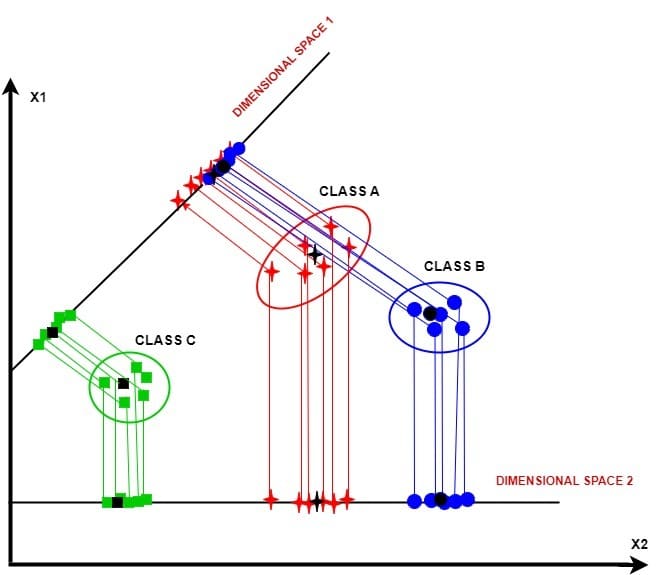
We observe three data clusters: class A, class B, and class C. Projecting along dimensional space 1 reduces within-class variance but loses between-class variance for classes A and B. Dimensional space 2 maintains both variances. Thus, we discard space 1 and use space 2 for LDA.
In tackling dimensionality reduction with LDA, we divide the process into three main steps.
The figure below illustrates these steps visually:
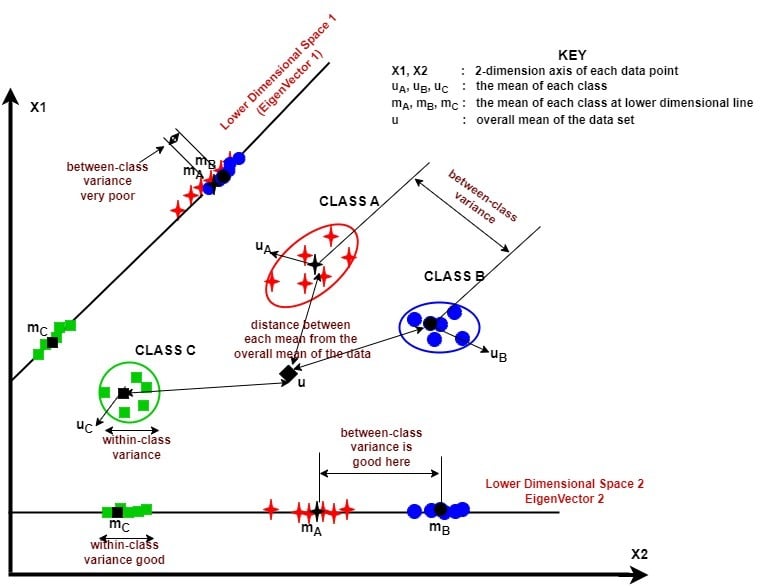
This newly constructed space simplifies our data and strengthens its power to distinguish between classes.
Exploring LDA, we encounter class-dependent and class-independent approaches. In class-dependent LDA, each class gets its own lower-dimensional space. Conversely, class-independent LDA treats each class separately but shares one lower-dimensional space.
In this section, we discuss the mathematical process for performing LDA.
To calculate the between-class variance , we follow the following steps:
We first calculate the separation distance as follows:
(1)
where, represents the projection of the mean of the
class which we calculate as follows:
.
is the projection of the total mean of classes which we calculate as follows:
,
where represents the transformation matrix of LDA,
represents the mean of the
class and we calculate it as follows,
.
is the total mean of all classes which we calculate as follows:
,
where is the total number of classes.
The term in equation 1 represents the between-class variance
of the
class.
We substitute into equation 1 as follows:
(2)
We now obtain the total between-class variance as follows:
(3)
To calculate the between-class variance , we take the following steps:
The within-class variance of the class
is the difference between the mean and the samples of that class.
We then search for a lower-dimensional space to minimize the difference between the projected mean and the projected samples of each class
, which is the within-class variance.
We capture these steps with the equations as follows:
(4)
From equation 4, we calculate the within-class variance as follows;
=
=
,
where represents the
sample in the
class and
is the centring data of the
class, i.e.
=
=
.
To calculate the total within-class variance of our data, we sum up the within-class variance of all classes present in our data as follows;
=
=
+
+ … +
.
To transform the higher dimensional features of our data into a lower dimensional space, we maximize the ratio of to
to guarantee maximum class separability by using Fisher’s criterion
, which we write this way:
(5)
To calculate the transformation matrix , we transform equation 5 into equation 6 as follows:
(6)
where represents the eigenvalues of the transformation matrix
Next, we transform equation 6 into equation 7 as follows:
(7)
we can then calculate the eigenvalues and their corresponding eigenvectors
of
given in equation 7.
In LDA, eigenvectors determine the direction of the space, while eigenvalues indicate their magnitude. We select the highest eigenvalue eigenvectors to form a lower dimensional space
, neglecting others. This reduces our original data
from dimension
to
. We write this new dimensional space
as:
(8)
Here, we describe the slight difference between the class-independent and class-dependent LDA approaches and also provide the algorithms for both.
In the class-independent method, we use only one lower-dimensional space for all classes. Thus, we calculate the transformation matrix for all classes, and we project the samples of all classes on the selected eigenvectors.
Here is the algorithm for the class-independent LDA approach:
In class-dependent LDA, we compute distinct lower-dimensional spaces for each class using . We find eigenvalues and eigenvectors for each
separately, then project samples onto their respective eigenvectors.
We provide the algorithm for the class-dependent LDA approach as follows:
In this section, we provide the computational complexities of the two classes of LDA
In analyzing the computational complexity of class-dependent LDA, we consider various steps. First, computing the mean of each class has complexity . Second, calculating the total mean has complexity
. Third, computing within-class scatter involves
. Fourth, calculating between-class scatter has complexity
. Fifth, finding eigenvalues and eigenvectors involves
. Sorting eigenvectors is
. Selecting
eigenvectors is
. Finally, projecting data onto eigenvectors is
. Overall, class-independent LDA has complexity
for
, otherwise
.
In analyzing computational complexity, both class-dependent and class-independent LDAs follow similar steps. However, class-dependent LDA repeats the process for each class, increasing complexity. Overall, class-dependent LDA complexity is for
, or
, surpassing class-independent LDA in complexity.
In this section, we will present a numerical example explaining how to calculate the LDA space step by step and how LDA is used to discriminate two different classes of data using the class-independent and class-dependent approach.
The first class is a
x
matrix with the number of samples
. The second class
is a
x
matrix with
. Each sample in both classes has two features (i.e.,
) as follows:
, and,
.
First, we calculate the mean for each class, and then the total mean
for both classes. The resulting answers are as follows;
,
, and
.
Next, we calculate the between-class variance of each class, and the total between-class variance
of the given data, as follows:
, so that,
similarly,
, so that,
becomes,
.
Next, we calculate the within-class variance . To do this, we perform the mean-centering data process by subtracting the mean of each class from each sample in that class. We achieve this as follows:
. Where
is the mean-centering data of the class
. The values of
and
becomes:
, and
.
In the next two sub-sections, we’ll present how the two LDA approaches solve this numerical example.
In this approach, after the data centering process, we calculate the within-class variance as follows:
. The values of
is as follows:
, and
.
becomes,
.
.
Next, we calculate the transformation matrix as follows:
. The values of
are
. The values of the transformation matrix become;
.
We then calculate the eigenvalues and eigenvectors
from
. Their values are as follows:
, and
Next, we project and
onto the first column vector
and the second column vector
of the matrix
to investigate which of the columns is more robust in discriminating the data.
Using , we project
on the lower dimensional space as follows:
,
Using the same eigenvector , we project
on the lower dimensional space as follows:
,
.
Next, we project and
to eigenvector
as follows:
,
and
,
.
From our results, we observe that is more robust in discriminating the classes
and
than
. This is because
is larger than
. Hence, we choose
to discriminate
and
instead of
.
In this approach, we aim to calculate a separate transformation matrix for each class
. The within-class variance for each class is the same as we calculated it in the class-independent approach, we then calculate
of each class as follows:
. The values of
and
becomes:
, and
.
Next, we calculate the eigenvalues and the corresponding eigenvectors
of each transformation matrix
.
The values of and
of
for
are as follows:
, and the corresponding eigenvectors are;
Similarly,the values of the eigenvalues and the corresponding eigenvectors
of
for the second class data
are as follows:
, and the corresponding eigenvectors are;
.
From the results above, we observe that of
for
has a bigger corresponding eigenvalue than
, this implies that
will discriminate
better than the
, thus, we chose
as the lower dimensional space to project
as follows;
.
For the second class , we also see that the second column eigenvector
of
has a higher eigenvalue than the first column eigenvector
, this also implies that
will discriminate better than the
. We obtain the projected data
for
as follows;
.
In the next sub-section, we present the visual illustration of the performance of LDA on the two classes of data and
and then draw our conclusions.
First, let us consider the class-independent LDA approach.
The next figures illustrate the probability density function (pdf) graphs of the projected data and
on the two eigenvectors
and
of matrix
:
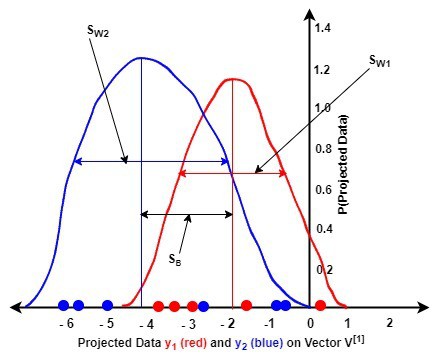
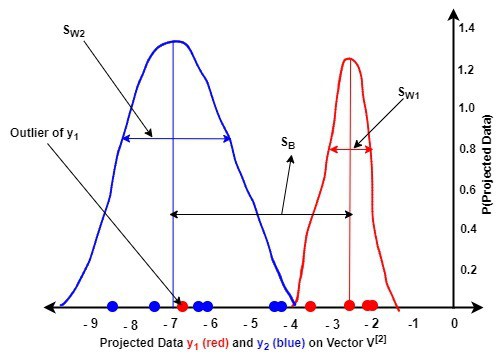
A comparison of the two figures reveals the following:
Let us investigate the class-dependent LDA approach:
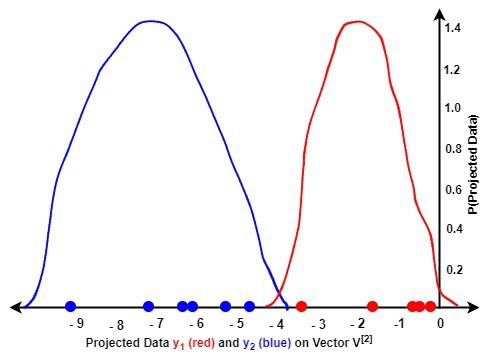
We observe that by projecting onto
of the first eigenvector and
onto
of the second eigenvector, we were able to discriminate the data efficiently. The corresponding eigenvectors achieved this by maximizing
and minimizing
of the data.
8. Conclusion
In our article, we explored linear discriminant analysis (LDA) through class-independent and class-dependent approaches. Our analysis revealed that while the class-dependent method is efficient, it demands more computational time than the class-independent approach. Consequently, the class-independent approach is commonly favoured as the standard method for LDA.